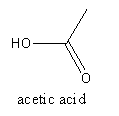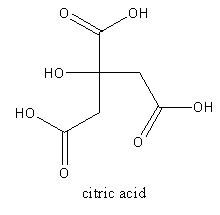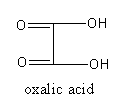
Match the following:
Natural Source Acid 1. Vinegar A. Oxalic Acid 2. Orange B. Acetic Acid 3. Tamarind C. Citric Acid 4. Tomato D. Tartaric acid
A. 1-a, 2-b, 3-d, 4-c
B. 1-b, 2-c, 3-d, 4-a
C. 1-a, 2-c, 3-d, 4-a
D. 1-d, 2-a, 3-b, 4-c
| Natural Source | Acid |
| 1. Vinegar | A. Oxalic Acid |
| 2. Orange | B. Acetic Acid |
| 3. Tamarind | C. Citric Acid |
| 4. Tomato | D. Tartaric acid |
Answer
560.4k+ views
Hint: The chemical formula and name of the acid present in the vinegar is ${\text{C}}{{\text{H}}_{\text{3}}}{\text{COOH}}$ ethanoic acid. The chemical formula and name of the acid present in the orange is ${{\text{C}}_{\text{6}}}{{\text{H}}_{\text{8}}}{{\text{O}}_7}$ $2 - $hydroxy propane$ - 1,2,3 - $tricarboxylic acid. The chemical formula and name of the acid present in the tamarind is ${{\text{C}}_4}{{\text{H}}_{\text{6}}}{{\text{O}}_{\text{6}}}$$2,3 - $Dihydroxy butanedioic acid. The chemical formula and name of the acid present in the tomato is ${{\text{C}}_2}{{\text{H}}_2}{{\text{O}}_4}$ ethanedioic acid.
Complete answer:
A molecule that can donate a proton or accept electrons is known as acid.
The acid present in vinegar is acetic acid which is systematically known as ethanoic acid. It is a weak acid. The chemical formula of the acetic acid is ${\text{C}}{{\text{H}}_{\text{3}}}{\text{COOH}}$.
The structure of acetic acid is as follows:

The acid present in orange is citric acid which is systematically known as $2 - $ hydroxy propane$ - 1,2,3 - $tricarboxylic acid. It is soluble in water. The molecular formula of the citric acid is ${{\text{C}}_{\text{6}}}{{\text{H}}_{\text{8}}}{{\text{O}}_7}$.
The structure of citric acid is as follows:

The acid present in tamarind is tartaric acid. It is an alpha-hydroxy carboxylic acid. The molecular formula of the tartaric acid is ${{\text{C}}_4}{{\text{H}}_{\text{6}}}{{\text{O}}_{\text{6}}}$. The IUPAC name of tartaric acid is $2,3 - $Dihydroxy butanedioic acid.
The structure of tartaric acid is as follows:

The acid present in tomato is oxalic acid. The molecular formula of the tartaric acid is ${{\text{C}}_2}{{\text{H}}_2}{{\text{O}}_4}$. The systematic name of oxalic acid is ethanedioic acid.
The structure of oxalic acid is as follows:

So, correct match of natural source and acid are as following:
Therefore, option (B) 1-b, 2-c, 3-d, 4-a, is correct.
Note: All acids have two carboxylic groups. The substance which has acids has a sour test. The pH of the liquid of these substances will be less than seven. Liquid of these substances can convert blue litmus into red which confirms the acidic nature of these substances. The main acid present in orange is ascorbic acid or vitamin C having molecular formula ${{\text{C}}_{\text{6}}}{{\text{H}}_{\text{8}}}{{\text{O}}_{\text{6}}}$. Ascorbic acid or vitamin C cannot be produced by the body and cannot be stored. It is obtained from the diet. It is necessary for the recovery of the tissues. Fruit and vegetables are rich sources of ascorbic acid.
Complete answer:
A molecule that can donate a proton or accept electrons is known as acid.
The acid present in vinegar is acetic acid which is systematically known as ethanoic acid. It is a weak acid. The chemical formula of the acetic acid is ${\text{C}}{{\text{H}}_{\text{3}}}{\text{COOH}}$.
The structure of acetic acid is as follows:

The acid present in orange is citric acid which is systematically known as $2 - $ hydroxy propane$ - 1,2,3 - $tricarboxylic acid. It is soluble in water. The molecular formula of the citric acid is ${{\text{C}}_{\text{6}}}{{\text{H}}_{\text{8}}}{{\text{O}}_7}$.
The structure of citric acid is as follows:

The acid present in tamarind is tartaric acid. It is an alpha-hydroxy carboxylic acid. The molecular formula of the tartaric acid is ${{\text{C}}_4}{{\text{H}}_{\text{6}}}{{\text{O}}_{\text{6}}}$. The IUPAC name of tartaric acid is $2,3 - $Dihydroxy butanedioic acid.
The structure of tartaric acid is as follows:

The acid present in tomato is oxalic acid. The molecular formula of the tartaric acid is ${{\text{C}}_2}{{\text{H}}_2}{{\text{O}}_4}$. The systematic name of oxalic acid is ethanedioic acid.
The structure of oxalic acid is as follows:

So, correct match of natural source and acid are as following:
| Natural Source | Acid |
| 1. Vinegar | B. Acetic Acid |
| 2. Orange | C. Citric Acid |
| 3. Tamarind | D. Tartaric Acid |
| 4. Tomato | A. Oxalic Acid |
Therefore, option (B) 1-b, 2-c, 3-d, 4-a, is correct.
Note: All acids have two carboxylic groups. The substance which has acids has a sour test. The pH of the liquid of these substances will be less than seven. Liquid of these substances can convert blue litmus into red which confirms the acidic nature of these substances. The main acid present in orange is ascorbic acid or vitamin C having molecular formula ${{\text{C}}_{\text{6}}}{{\text{H}}_{\text{8}}}{{\text{O}}_{\text{6}}}$. Ascorbic acid or vitamin C cannot be produced by the body and cannot be stored. It is obtained from the diet. It is necessary for the recovery of the tissues. Fruit and vegetables are rich sources of ascorbic acid.
Recently Updated Pages
Master Class 11 Accountancy: Engaging Questions & Answers for Success

Master Class 11 Science: Engaging Questions & Answers for Success

Master Class 11 Business Studies: Engaging Questions & Answers for Success

Master Class 11 English: Engaging Questions & Answers for Success

Master Class 11 Computer Science: Engaging Questions & Answers for Success

Master Class 9 General Knowledge: Engaging Questions & Answers for Success

Trending doubts
What are the major means of transport Explain each class 12 social science CBSE

Sketch the electric field lines in case of an electric class 12 physics CBSE

Explain the formation of energy bands in solids On class 12 physics CBSE

Mention any two factors on which the capacitance of class 12 physics CBSE

Drive an expression for the electric field due to an class 12 physics CBSE

Draw a ray diagram of compound microscope when the class 12 physics CBSE




